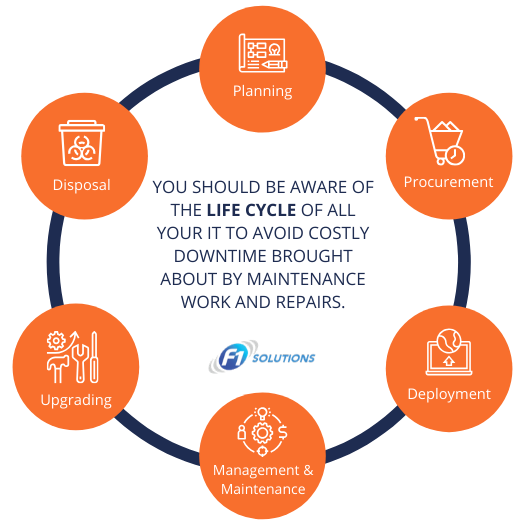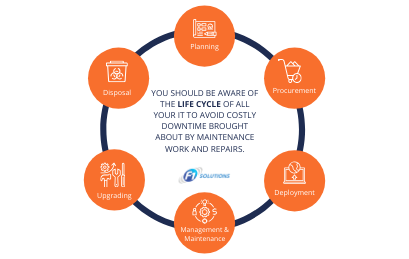Many small- to medium-sized businesses (SMBs) today are using the latest technologies to revolutionize their day-to-day operations. State-of-the-art computers and software help improve the performance of your employees, as well as the overall processes of your business. However, you should be aware of the life cycle of all your IT to avoid costly downtimes brought about by maintenance work and repairs.
What is IT life cycle management?
IT life cycle management is a process of proactively managing the total life span of your company's IT assets. Instead of buying a new piece of technology only when your existing one breaks down, this process phases out your technology with intent and plans for the next purchase based on your company’s needs and budget. This allows you to fully utilize your devices and applications, and get the best returns on your investments.

What are the processes involved in IT life cycle management?
IT life cycle management involves numerous steps, including:
#1 Planning
Successful IT life cycle management relies heavily on the planning stage. During this process, a full review of your company's existing infrastructure is done to identify deficiencies and opportunities where infrastructure can be extended. Your IT staff or a managed IT services provider (MSP) should help you create a life cycle management plan that will align with your business objectives and budget.
#2 Procurement
The procurement process is where you purchase necessary equipment. Make sure to only buy from trusted vendors with extended support and warranties. Before buying new equipment, you should also know what the equipment will be used for so appropriate sizing of drives and motherboards can be provided.
#3 Deployment
The deployment process involves the tagging, installation, and system configuration of new equipment and software. Since this part of the process is time-consuming, partnering with a reputable MSP will make the task faster and easier. Here’s what an MSP will do during the deployment process.
- Stage the new equipment
- Schedule the installation of new assets
- Install new hardware and software
- Train users about the new equipment
#4 Management and maintenance
This process involves monitoring, providing updates and support, and ensuring your company continuously complies with strict security standards and regulations to avoid hefty fines. Your MSP will assist you by doing the following:
- Schedule regular scans
- Monitor equipment usage
- Calculate asset depreciation
- Ensure software compliance
- Manage software licenses
#5 Upgrading
Aside from undergoing regular maintenance, IT hardware and software also need ongoing upgrades to extend their life cycle. Your MSP can perform regular audits to help you identify which part of your infrastructure needs to be upgraded. They will help you find the necessary components, as well as recommend affordable alternatives to keep your expenses low.
#6 Disposal
The final step of the life cycle management process is disposing of any hardware or software that has reached or is about to reach the end of its life and replacing them with new ones to avoid costly downtime. In addition, you have to make sure that any sensitive information is removed from the devices that will be disposed of. During this process, your MSP will:
- Remove retired assets
- Change an asset’s state to expired or disposed
- Un-allocate any software from expired or disposed assets
What are the benefits of IT life cycle management?
Implementing IT life cycle management for your assets comes with a variety of benefits such as:
- Reducing maintenance costs
- Improving the life span of devices
- Maximizing the value from hardware and software
- Optimizing the upgrading process
- Managing unwanted assets
What are the requirements for IT life cycle management?
Before implementing IT life cycle management in your organization, you must do the following:
- Have a complete list of every device connected to your network.
- Create a log that states the purpose, use, and history of each asset.
Implementing IT life cycle management is a must for any business because it allows business owners to anticipate potential IT issues and avoid unnecessary costs. F1 Solutions can help business owners such as yourself come up with a strategic IT life cycle management plan tailored to your organization’s specific needs.
When is the best time to implement IT life cycle management?
IT life cycle management can be implemented anytime; however, it's best to use this process when you're introducing new hardware and software into your network.
If you want to implement IT life cycle management into your organization, your first step is to consult a trusted MSP like F1 Solutions. Our IT experts will examine the current state of your IT infrastructure and identify issues that need to be addressed.



